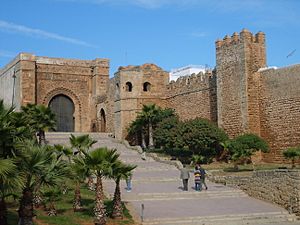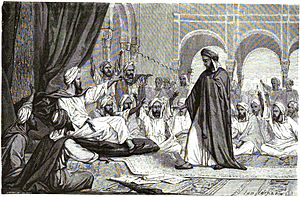Yaqub al-Mansur facts for kids
Quick facts for kids Yaqub Al-Mansur |
|||||
|---|---|---|---|---|---|
| Amir al-Mu'minin | |||||

Yaʿqūb al-Manṣūr's unfinished mosque in Rabat
|
|||||
| Ruler of the Almohad Caliphate | |||||
| Reign | 1184–1199 | ||||
| Predecessor | Abu Yaqub Yusuf | ||||
| Successor | Muhammad al-Nasir | ||||
| Born | 1160 | ||||
| Died | 23 January 1199 (aged 38–39) Marrakesh |
||||
| Burial | Marrakesh | ||||
| Spouse | Ammet Allah bint Abu Isaac Safiya bint Abu Abdallah ben Merdnych |
||||
| Issue | Muhammad al-Nasir Idris al-Ma'mun |
||||
|
|||||
| Dynasty | Almohad | ||||
| Father | Abu Yaqub Yusuf | ||||
| Religion | Islam | ||||
Abū Yūsuf Yaʿqūb ibn Yūsuf ibn Abd al-Muʾmin al-Manṣūr (Arabic: أبو يوسف يعقوب بن يوسف بن عبد المؤمن المنصور), known as Yaqub al-Mansur (يعقوب المنصور), was a powerful ruler of the Almohad Caliphate. He was the third Caliph of the Almohad dynasty, ruling from 1184 to 1199. During his time, trade, building, and new ideas in science and thinking grew a lot. He also won many important battles, especially in the Iberian Peninsula (modern-day Spain and Portugal), where he fought against Christian kingdoms.
Contents
A Powerful Ruler: Yaqub al-Mansur
Yaqub al-Mansur became ruler after his father passed away in 1184. He was in Seville when he was announced as the new Caliph. He promised to get revenge for his father's death. First, he had to deal with a group called the Banu Ghaniya in Africa. After defeating them, he traveled to the Iberian Peninsula to fight the Christian armies there.
Battles and Victories
Yaqub al-Mansur was a skilled military leader. He led his armies in many important battles. His goal was to protect the lands controlled by the Almohads in Iberia.
Fighting in Iberia
In 1190, he tried to capture the fortress of Tomar in Portugal, but he wasn't successful. However, in 1191, he won back Paderne Castle and the land around it from the Portuguese army. He won other battles against Christian forces and captured several cities. After these victories, he returned to Africa, taking many Christian prisoners with him.
While he was away, Christian armies in the Iberian Peninsula started to take back cities like Silves, Vera, and Beja. When Yaqub al-Mansur heard this, he quickly returned to Iberia. He defeated the Christians again, and many were taken as prisoners.
The Great Battle of Alarcos
The Christian kingdoms then gathered a very large army, said to be over 300,000 men, to defeat Yaqub al-Mansur once and for all. But Yaqub al-Mansur returned to Iberia again. On July 18, 1195, he led his forces to a huge victory against King Alfonso VIII of Castile at the Battle of Alarcos. This battle was a massive win for the Almohads. It was said that a huge number of Christian soldiers were defeated, and the Almohads took a vast amount of treasure. After this great victory, Yaqub took the title al-Mansur Billah, which means "Made Victorious by God."
Building a Legacy
Yaqub al-Mansur was not just a military leader; he also loved to build and create. He started many large construction projects during his rule.
Amazing Buildings and Cities

In Rabat, he added a grand gate to the Kasbah of the Udayas. He might have also finished building the famous Kutubiyya Mosque in Marrakesh. He also built a huge royal palace and fortress in Marrakesh, which became the center of government for many years. This royal area included the Kasbah Mosque and the impressive gate of Bab Agnaou, both built during his time.
He also started building a massive new capital city in Rabat. He planned to build what would have been the largest mosque in the world there. However, construction on this mosque and the new city stopped after he passed away. Only the beginning parts of the mosque were finished, including its tall minaret, now known as the Hassan Tower. Some of Rabat's historic gates, like Bab er-Rouah, were also built during his reign. One of his most famous works was the Bimaristan of Marrakesh, which was the first hospital ever built in Morocco. It had beautiful decorations, gardens, and water canals, and the Almohad government paid for it. It is said that the famous thinker Averroes worked there for a time.
A Focus on Learning and Justice
Yaqub al-Mansur was very interested in learning and religion. He supported the philosopher Averroes and kept him close to his court. Like other Almohad rulers, Yaqub al-Mansur was very knowledgeable about religious teachings. He preferred a specific way of understanding Islamic law, which focused on the exact meaning of religious texts. He even wrote his own book about the sayings and actions of the prophet Muhammad. He told his judges to make decisions only based on the Qur'an and the clear sayings of the prophet. He also ordered that religious books that did not follow his specific teachings be removed.
His Final Years and What He Left Behind
Yaqub al-Mansur passed away on January 23, 1199, in Marrakech.
His great victory at the Battle of Alarcos was remembered for many centuries, even when the tide of war later turned against the Muslim side. A historian named Ibn Abi Zar wrote about it in his book Rawd al-Qirtas in 1326. The town of Moulay Yacoub, near Fez in Morocco, is named after him and is known for its healing hot springs.
| Preceded by Abu Ya'qub Yusuf |
Almohad Caliph 1184–1199 |
Succeeded by Muhammad al-Nasir |
See also
 In Spanish: Abu Yúsuf Yaacub al-Mansur para niños
In Spanish: Abu Yúsuf Yaacub al-Mansur para niños


